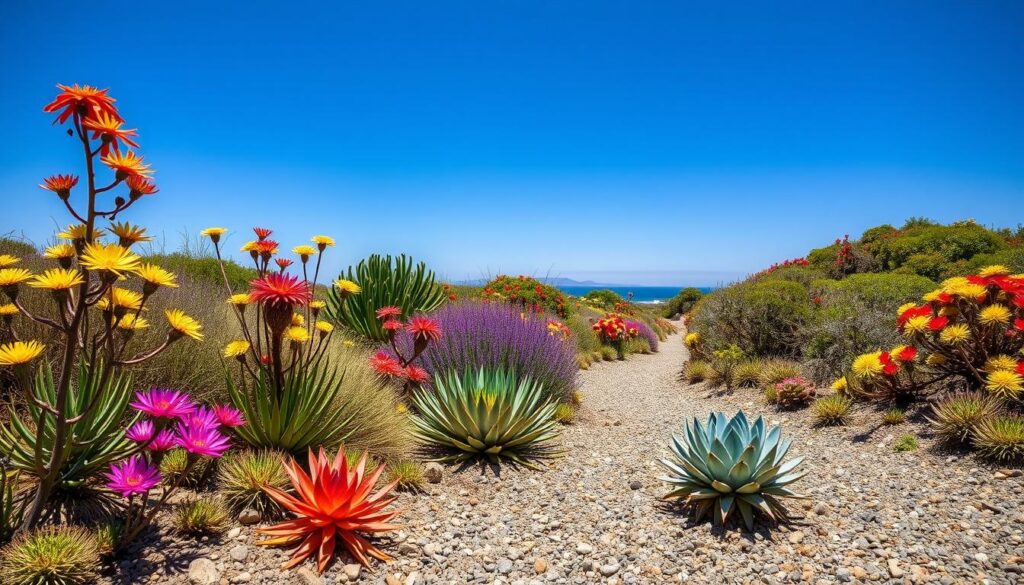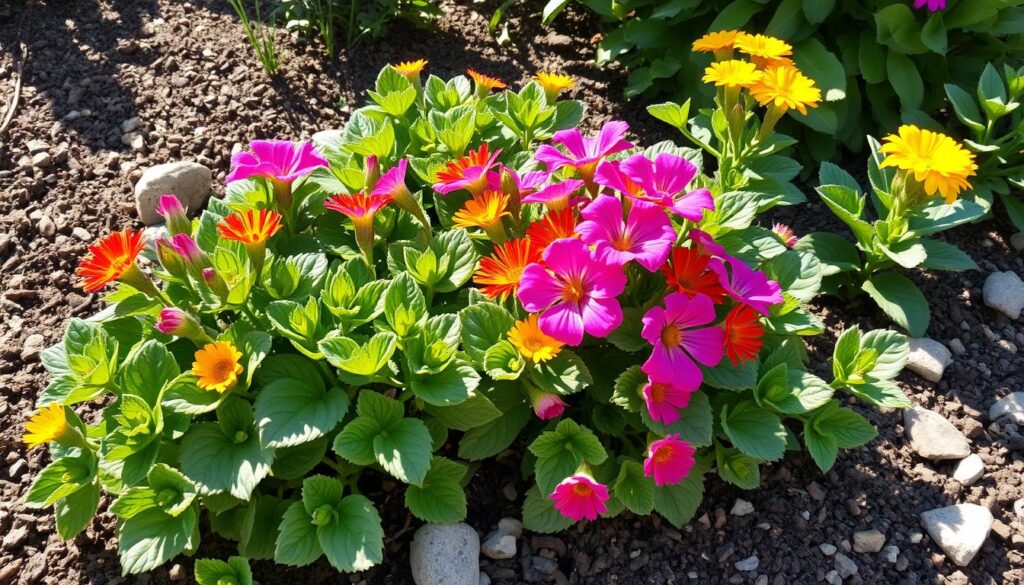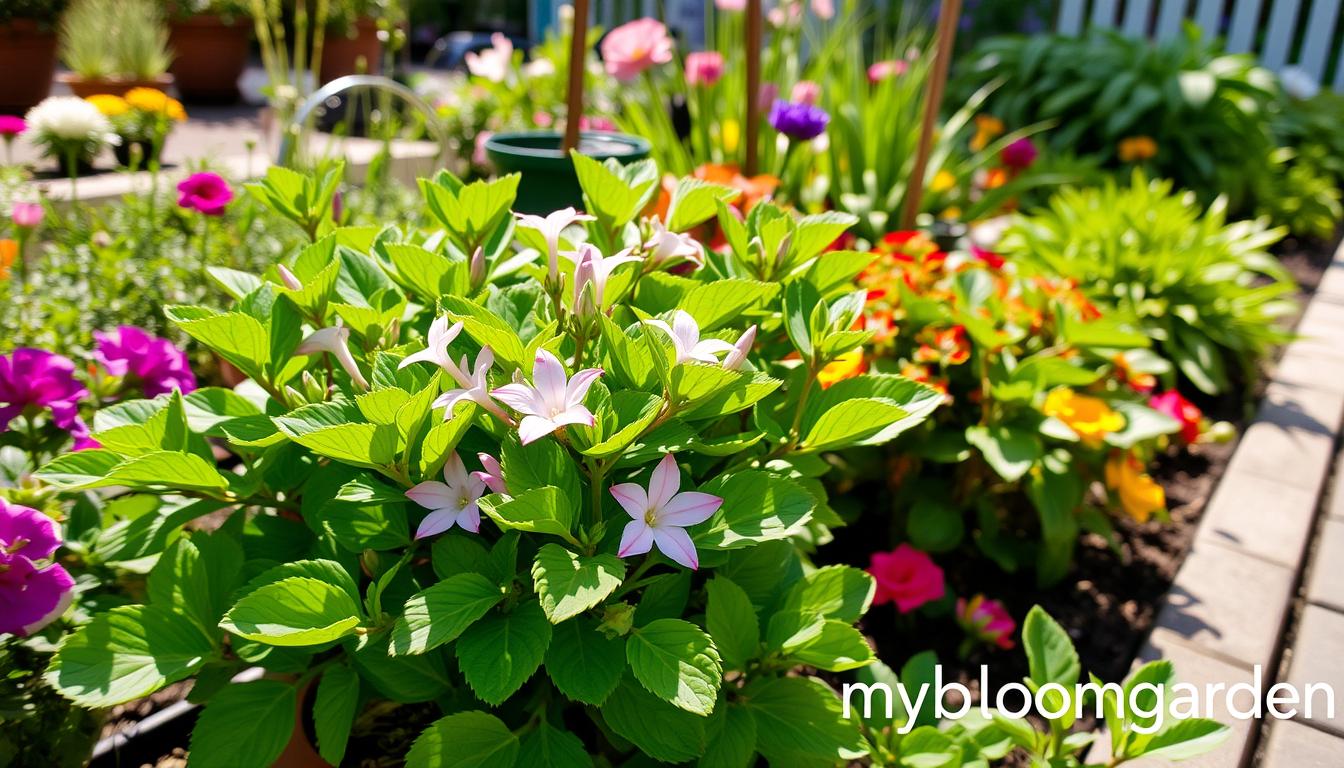I’ve always loved thrift plants for their charm. They’re tough, drought-resistant, and brighten up any garden. They’re perfect for coastal gardens, adding color and texture. Growing them is a rewarding experience for any gardener.
Thrift plants, or sea pinks, are great for many garden types. They grow well in coastal areas and as ground covers. This guide will help you grow and care for these beautiful plants in your garden.
Table of Contents
Understanding Thrift Plants: A Coastal Garden Beauty
Looking to add coastal charm to your garden? Thrift plants are a great choice. These perennials love the sandy, well-drained soils and windy conditions of the seaside.
Native Habitats and Growth Characteristics
Thrift plants, or sea pinks, thrive in coastal areas worldwide. They grow well in the harsh conditions of cliffs and beaches. These plants have a compact shape and tough, water-saving leaves.
Common Varieties for Home Gardens
Many thrift plant species are great for home gardens. Armeria maritima, the common thrift, has pretty pink or white flowers. Armeria juniperifolia, the juniper-leaved thrift, is more compact and fits well in rock gardens.
Plant Description and Features
Thrift plants have a low, tufted look and bright flowers in pink, white, or purple. Their evergreen leaves add interest all year. These drought-tolerant and perennial plants are perfect for coastal plant and rock garden settings.
“Thrift plants are a true embodiment of coastal garden charm, adding a touch of whimsy and resilience to any landscape.”
Essential Growing Requirements for Thrift Plant Success
Thrift plants, also known as sea pinks, are a stunning addition to any garden. These edging plants, ground covers, and succulents love well-draining, sandy soil. They’re perfect for xeriscaping and coastal gardens.
For your thrift plants to thrive, focus on their light needs. They love full sun, needing at least 6 hours of direct sunlight daily. While they can handle partial shade, it might make their blooms less vibrant and their growth more compact.
- Thrift plants do well in cooler climates. They can handle frost and even light freezing without problems.
- They need well-drained soil to thrive. Add organic matter or sand to your soil to improve drainage and prevent waterlogging.
- Feed your thrift plants lightly with a balanced, slow-release fertilizer made for succulents and edging plants. Don’t overdo it, as too much fertilizer can make them grow too much foliage at the expense of flowers.
“Thrift plants are a true gem in the gardening world, offering a low-maintenance, drought-tolerant option that adds a pop of color and texture to any landscape.”
By meeting the specific needs of thrift plants, you can enjoy their beautiful blooms and foliage for many years. Whether you’re setting up a stunning rock garden or enhancing your coastal garden, these versatile plants will surely impress.
Soil Preparation and Planting Techniques
To grow thriving thrift plants, start with good soil. These plants love well-draining, sandy soils with a slightly acidic pH. Mix compost or organic matter into your garden bed to make the soil light and airy.
Best Soil Types and pH Levels
Thrift plants do best in a soil pH of 6.0 to 7.0. Check your soil pH and adjust it with lime or sulfur if needed. Sandy loam or sandy soil with great drainage is best, as thrift plants can get root rot in wet conditions.
Spacing and Planting Depth Guidelines
- Space thrift plants 12 to 18 inches apart for good growth and air.
- Plant them 2 to 3 inches deep, with the crown level with the soil.
Timing Your Planting Season
Plant thrift in the spring or fall when it’s cooler. Don’t plant in the hot summer, as seedlings may have trouble. Planting at the right time helps your thrift plants thrive.
“Thrift plants are a true delight in the garden, offering a splash of color and a drought-resistant presence that can’t be matched.”
Watering and Drought Tolerance Strategies
Xeriscaping plants, like thrift or coastal plants, are great for dry areas. They have special features that help them survive without much water. This makes them perfect for gardens in dry places or where water is scarce.
Knowing how to water these plants is key. Thrift plants need water only once or twice a week when it’s very hot. But, too much water can harm them, so let the soil dry a bit before watering again.
- Make a watering plan that fits your local weather.
- Water in the morning or evening to save water.
- Use mulch to keep the soil moist and stop weeds.
“Thrift plants are true champions of xeriscaping, thriving in dry, coastal conditions where other plants may struggle.”
Thrift plants also do well in salty soil, common in coastal areas. Adding these succulent plants to your garden makes it beautiful and easy to care for. It also uses less water.

By using xeriscaping and choosing drought-tolerant plants like thrift, you save water and effort. Your garden will stay lively and green, even in tough weather.
Creating the Perfect Rock Garden Display
Rock gardens are perfect for showing off thrift plants’ beauty. These plants love dry, rocky soil and add a coastal vibe. With the right design and care, your rock garden will be a hit.
Design Principles for Rock Gardens
Design your rock garden to look natural and a bit rough. Use big rocks to set the scene and fill in with smaller stones. Mix different thrift plants for texture and color.
Companion Plants for Visual Impact
Thrift plants are great for edges, but they also look good with other plants. Try adding succulents, herbs, or colorful perennials. This mix will make your garden pop.
Maintenance Tips for Rock Garden Settings
- Keep weeds out to keep your garden looking neat.
- Top up mulch or gravel to stop weeds and keep soil moist.
- Trim thrift plants to keep them blooming and looking good.
- Watch for pests and diseases to keep your plants healthy.
Follow these tips to make a beautiful rock garden with thrift plants. They’re perfect for low-maintenance, drought-tolerant gardens.
Seasonal Care and Maintenance Schedule
Keeping your thrift plant, a perennial flowering evergreen from coastal areas, healthy and blooming is key. A regular care routine is essential. This ensures your thrift plant stays vibrant all year.
In early spring, trim off dead or damaged leaves. Then, use a balanced, slow-release fertilizer to feed the plant and boost growth. As it gets warmer, water your thrift plant often. Make sure the soil is moist but not too wet.
In the hot summer, remove spent flowers to keep the plant blooming. Also, add mulch around the base. It keeps the soil moist and stops weeds.
When fall comes, water less and let the soil dry a bit between waterings. This helps the plant get ready for winter. In late fall or early winter, lightly prune the thrift plant to keep it neat.
All year, watch for pests or diseases on your thrift plant. Deal with them quickly to keep the plant healthy. By sticking to this care plan, your thrift plant will bloom beautifully for many years.
Propagation Methods and Division Techniques
There are two main ways to grow thrift plants: seeds or division. Each method has its own benefits. Knowing the differences helps you pick the best way for your garden.
Seeds vs. Division Methods
Starting thrift plants from seed can be rewarding but slow. Seeds may take weeks to sprout, and the plants might not look like the parent. On the other hand, dividing mature thrift plants is quicker and more reliable. It ensures new plants are just like the original, making your garden look consistent.
Step-by-Step Division Guide
- Dig up a mature thrift plant carefully, getting as much root as you can.
- Use a sharp knife or pruners to split the plant into smaller parts. Each part should have roots and leaves.
- Plant the divided parts in soil that drains well and is rich in nutrients. Follow the spacing advice for your thrift plant type.
- Water the new plants well and keep the soil moist until they settle in.
Post-Propagation Care Tips
After growing your thrift plants by seed or division, they need the right care. Make sure they get enough sunlight, water, and nutrients. With some patience and care, your thrift plant efforts will pay off. You’ll have a beautiful, ground-covering perennial in your garden.
Troubleshooting Common Growth Issues
Growing thrift plants can be rewarding but comes with challenges. Whether you’re experienced or new, knowing how to fix common problems is crucial. This helps keep your drought-tolerant and coastal plants healthy in your xeriscaping.
Pests like aphids, spider mites, and thrips can harm these flowers. To fight them, check your plants often. Use a mild insecticidal soap or neem oil to keep pests away.
Diseases such as powdery mildew and root rot can also harm your plants. To prevent this, make sure air circulates well and the soil drains well. Avoid too much water. If you see disease, cut off the affected parts quickly to stop it from spreading.
Extreme heat, cold, or drought can stress your plants. Make sure they get the right sunlight and water. Mulching around the base helps keep soil moist when it’s dry.
By watching for and fixing problems early, your thrift plants will stay healthy. They’ll add a beautiful coastal touch to your xeriscaping.

“The key to success with thrift plants is understanding their unique needs and providing the right growing conditions.”
Conclusion
Thrift plants are a true gem in the gardening world. They are resilient and low-maintenance. They offer many benefits, from their striking ground-cover display to their ability to thrive in challenging coastal environments.
Whether you’re drawn to their vibrant, flowering foliage or their versatility as a succulent choice, thrift plants are a great addition to your landscape. They are perfect for creating captivating rock garden displays or adding pops of color to your borders.
Thrift plants are drought-tolerant and adaptable. This makes them an ideal choice for busy homeowners who want a beautiful garden with minimal effort. As you continue to cultivate your outdoor space, remember the lessons you’ve learned about caring for these coastal wonders.
Whether you’re a seasoned green thumb or a beginner gardener, thrift plants offer endless opportunities for exploration and enjoyment. Embrace their beauty and let their resilience and charm inspire you to create a landscape that reflects your personal style and love for nature.

